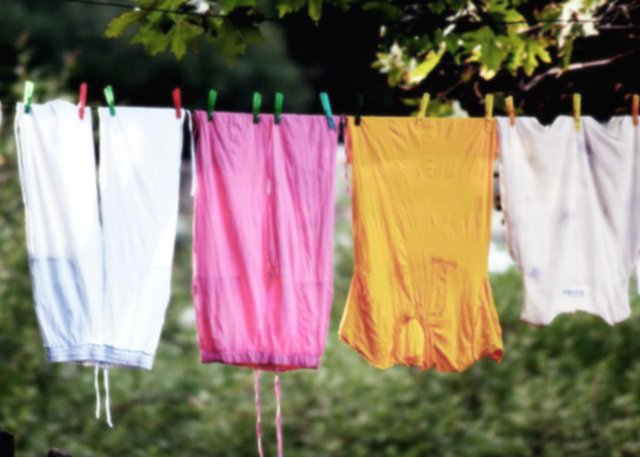I was reading through a stack of old parenting magazines last week looking for anything I might want to clip and keep before recycling them and ran across an article that grossed me out. It was discussing a report on household germs and the places they show up where most people don’t think to look.
Places like laundry. CLEAN laundry. Anyone else bothered by this? You think clean laundry would be, well, clean—apparently not.
Some of the statistics were both depressing and disgusting; some items are COMING OUT of the wash with fecal matter, bacteria, and viruses on them. Yes, I said the f-word. Some of the things known to show up in supposedly clean laundry include salmonella, e. coli, and the flu virus. How impossibly gross is that?
The culprit is our modern lifestyle.
People rarely wash in hot water due to rising costs of heat and increased availability of cold water-friendly detergents. Personally, outside of the times when my girls were in cloth diapers and our bout of family-wide pink eye, I have never washed my laundry in hot water. It just seemed like an unnecessary expense.
According to the CDC (Center for Disease Control) in order to be effective in killing germs laundry (linens) needs to be processed at a minimum of 160 degrees Fahrenheit for at least twenty-five minutes. I don’t know about you but my water heater is set to not get hotter than 120 for safety reasons.
The other half of the cleansing equation is sunlight. Very few people have, take, or make the time to hang their laundry outdoors to dry. Which is a shame since sunlight kills germs. I didn’t know that. Did you?

Most clothes dryers do not get hot enough for long enough to kill off all the bacteria, viruses, and parasites that survive the washer.
So… If we want to save energy and don’t have time to hang our laundry, what can we do?
-
Wash most of your laundry in cold, but make an exception for items like bedding, underclothes, diapers, and socks; these are the items most likely to carry bodily waste and germs like the ones that cause athlete’s foot. Wash these in hot water and, if possible without damaging the fabric, bleach them as well. Color-safe bleaches offer enhanced color protection but do not have the germ killing power of chlorine bleach.
-
Wash the items listed above LAST so that any germs that survive the wash cycle are not passed on to other items.
-
Don’t wash colored underwear with other colored clothes, save them for the bleach load. Chlorine bleach can be used on color-safe fabrics, if diluted properly (check manufacturer’s directions and/or website), but you should test the diluted mix on a part of the garment not readily visible(again, according to the directions) just to be sure.
-
Don’t hug your laundry. Lots of us cradle dirty laundry as we take it to the washing machine, particularly items like bedding, which passes the germs from the unwashed laundry to your skin and clothing and from there you may spread it all over the house. This is especially true in the case of kids’ bedding.
-
If you’re like me, you carry the dirty laundry to the washing machine in a hamper, sort it, and when the clean laundry is ready, you put it back in the same hamper to take it to the rooms to put away. Add a new step in-between and take a moment to use a surface disinfectant (like Lysol) on the hamper between the dirty and clean loads. Make sure you allow the disinfectant time to dry, too.
-
Pine oil can be used as a laundry disinfectant, but the product you use must contain at least 80% pine oil to be effective.
-
Phenolic disinfectants (like Pine Sol) can also be used (following the manufacturer’s directions) as a laundry disinfectant and are safe for use with most washable fabrics.
-
Oxygen bleaches (Oxy Clean, Oxygen Power) are NOT enough to kill germs in your laundry; they require a separate activator of some kind (the articles I found on this got a little chemistry-technical for me or I’d explain more).
- Clean your machine. Periodically run the machine on a low water cycle, empty, and add a cup of chlorine bleach.
For more information on the man behind much of this germ science, look up Dr. Charles Gerba on your favorite search engine. In the meantime, stay safe!

